Prior to 1949, the body of literature about psychedelics was quite small, consisting of a handful of medical case reports from the late 19th and early 20th centuries, a few descriptions of the use of peyote and mescaline, and a small selection of journal articles. Then, around 1949, research into LSD and (to a lesser extent) other psychedelic drugs increased dramatically, with more than 1,000 scientific articles published by 1959 and a few books about peyote, mescaline, and LSD emerging in the late 1950s. In the 1960s, publication skyrocketed around the world, and the genre of psychedelic-focused print periodicals targeted at psychedelic
was created.
Over the past 50 years, a shared belief behind many of these magazines, journals, and zines was that psychedelic users needed more helpful information and that, due to legal controls on these substances, this information needed to come from within the underground or counterculture itself. Such publishing is a nerve-wracking enterprise that takes a particular type of determined editor and publisher. It was not unusual for a new underground title to last only one or two issues, with funding and resources difficult to come by, and subscribers nervous about signing up.
A few common topical threads run through many of these periodicals: an interest in balancing what is seen as skewed information provided by mainstream or government sources, bringing together multidisciplinary experts, documenting the benefits of psychedelics while reducing harms, helping people integrate their experiences, and encouraging the development of the psychedelic subculture.
, a couple of notable articles and journal issues broke psychedelic ground, such as the influential May 1957
magazine article, "Seeking the Magic Mushroom", describing R. Gordon Wasson's experiences with psilocybin-containing mushrooms in Mexico, as well as a 1963 topical issue of the
, "Drugs and the Mind", devoted entirely to psychedelic drugs and containing contributions from Timothy Leary, Richard Alpert, Richard Evans Schultes, and Wasson. Many more small psychedelic newsletters and newspapers have been produced than there is space to include in the timeline, though each has played a part in the evolution of underground psychedelic information.
| |
1963 - 1971 | | Psychedelic Review | MA, USA |
|
|---|
| |
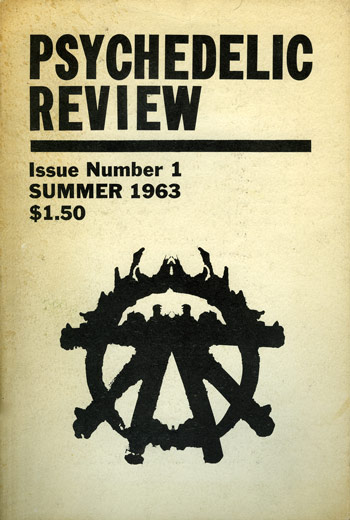 | |
One of the earliest and best-known publications devoted to psychedelics and the first to use the term "psychedelic" in its name, the Psychedelic Review had a stated purpose of serving as a forum for the exchange of information and ideas about the alteration and expansion of consciousness. Originally published by the International Federation for Internal Freedom (IFIF), which was founded by Timothy Leary and Richard Alpert (Ram Dass), the Psychedelic Review included editorial rants, scientific articles, and poetry. It boasted many of the most influential people of the 1960s psychedelic movement as editors: Ralph Metzner, Lisa Bieberman, Willis Harman, Frank Barron, Humphry Osmond, Huston Smith, and Alan Watts, as well as Leary and Alpert. |
|
|
| |
1965 - 1971 | | Psychedelic Information Center Bulletin | MA, USA |
|
|---|
| |
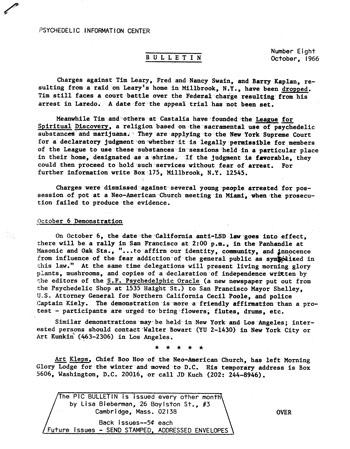 | |
This bi-monthly publication of the Psychedelic Information Center tracked the status of various counter-culture groups and projects and sought to provide "practical information regarding how to obtain and use LSD and other psychedelics". It was produced out of her apartment by Lisa Bieberman, a lover and follower of Timothy Leary who had previously helped run IFIF. Bieberman was arrested and tried in 1966 for selling LSD-impregnated sugar cubes to an undercover FDA inspector at a time when LSD was not yet federally illegal in the U.S. She was convicted for violating FDA regulations about shipping drugs but received a suspended sentence. |
|
|
| |
1966 - 1968 | | The San Francisco Oracle | CA, USA |
|
|---|
| |
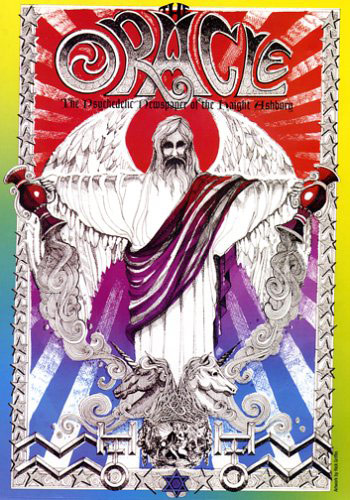 | |
This underground counterculture newspaper was co-founded and edited by poet Allen Cohen and artist Michael Bowen. In 1966, Cohen reportedly had a dream of a rainbow-colored newspaper circulating worldwide. When he described this dream to the founders of the Psychedelic Shop, one of the first head shops on Haight Street, they offered funding...and The Oracle was born. Known for its bright psychedelic art designs, its support of counterculture ideology, and its connection to the 1967 Human Be-in, its distribution peaked at more than 125,000 copies. For a while, The Oracle kept its offices open 24 hours a day, with the night crew feeding hungry hippies and guiding lost trippers. A lush book reproducing every issue of The Oracle was published in 1991. |
|
|
| |
1966 - 1967 | | Inner Space | NY, USA |
|
|---|
| |
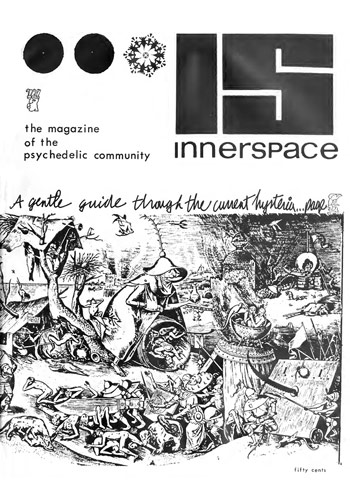 | |
This early zine, billing itself as "The Magazine of the Psychedelic Community", was founded in reaction to the ongoing control of psychedelic substances. Inner Space aspired to serve as a "clearing-house" for information about the potential benefits of psychedelics; its initial issue included a manifesto lamenting the lack of "positive useful data" available to the millions of users. Early issues included articles by Timothy Leary, Peter Stafford, Art Kleps, and Lisa Bieberman, as well as book reviews, research abstracts, discussion of media mentions of psychedelics, and related event announcements. |
|
|
| |
1967 - 1973 | | Oz | ENGLAND |
|
|---|
| |
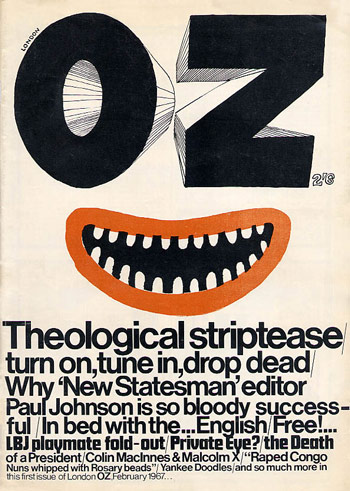 | |
Founded as an Australian anti-establishment magazine in 1963, Oz moved to London in 1967 and became a psychedelic counterculture magazine. A member of the Underground Press, Oz was part of a 1964 obscenity trial in Australia and another in the UK in 1971 when its co-editors were accused of conspiring to corrupt the morals of children with sexual and drug content. This became the longest obscenity trial in British history, resulting in a conviction that was overturned on appeal. The youngest editor, Felix Dennis, went on to become a wealthy entrepreneur, author, and publisher of magazines such as Maxim, Fortean Times, and The Week. |
|
|
| |
1967 - 1981
1981 - Present | | The Journal of Psychedelic Drugs
The Journal of Psychoactive Drugs | CA/WI, USA |
|
|---|
| |
 | |
Founded in 1967 with a mission to "compile and disseminate objective information related to the various types of drugs used in the Haight-Ashbury subculture", the Journal of Psychedelic Drugs began as the publication of the Haight-Ashbury Free Clinic in San Francisco. Originally a counterculture publication focusing on psychedelic drugs and cannabis, it fairly quickly shifted its attention to include more problematic substances such as heroin and stimulants. In 1981, it changed its name to the Journal of Psychoactive Drugs and is now one of the leading journals focusing on psychoactive drug use, abuse, and treatment. |
|
|
| |
1971 - 1973 | | Der Grüne Zweig | GERMANY |
|
|---|
| |
| |
Produced by Werner Pieper, this German publication was started--with money earned from dealing drugs--out of a sense of responsibility to his customers who were facing a lack of German-language information about psychedelics. Among other drug-related content, it published some of the first translations of articles by Leary, Lilly, and McKenna. Today Der Grüne Zweig is a publisher's imprint. |
|
|
| |
1971 - Present | | Journal of Drug Issues | FL, USA |
|
|---|
| |
 | |
Begun as a non-profit in 1971, JDI came under the control of Florida State University in 1996. JDI provides a professional forum for mainstream discussion of problems associated with illicit drugs. Articles focus on "harder" drugs, substance abuse treatment, adolescent drug use, and problems such as disease and homelessness associated with the use of psychoactives. |
|
|
| |
1973 - 1980
1981 - 2001 | | Journal of Altered States of Consciousness
Imagination, Cognition, and Personality | NY, USA |
|
|---|
| |
| |
This journal, renamed in 1981, addressed cannabis and psychedelics, but from a focus on consciousness and self-awareness rather than on psychoactive substances or drug-using cultures. Early issues also covered ritual trance, meditation, religious thought, dream states, astral travel, creativity, and psychosis. |
|
|
| |
1974 - Present | | High Times | NY, USA |
|
|---|
| |
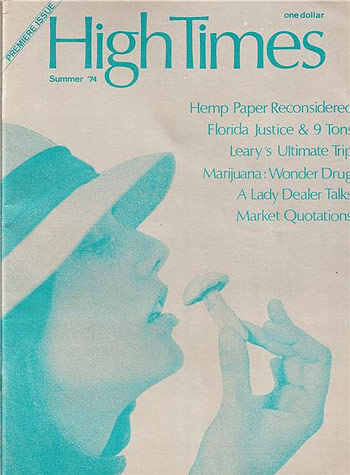 | |
Founded by Tom Forcade, an underground publisher, writer, cannabis smuggler, and Yippie activist. Forcade is credited with, among other things, being one of the first to throw a pie at a person in political protest after "pieing" the chairman of the President's Commission on Obscenity and Pornography in 1970. Many stories about the early High Times describe surprising interactions with large-scale cannabis smugglers. Though the magazine has a strong focus on cannabis, it also includes articles about psychedelics and other drugs. High Times, which was modeled after Playboy, is now the largest cannabis-related print publication in the world with a circulation of more than 200,000. |
|
|
| |
1977 - 1979 | | The Australasian Weed/Seed/Need/Greed/Pleed/?eed | AUSTRALIA |
|
|---|
| |
| |
This pro-drug publication aspired to be the voice of cannabis smokers in Australia. This task was complicated when The Australasian Weed was banned or restricted in most Australian states. To sidestep the bans the name was changed to The Australasian Seed. Keeping one step ahead of the law, they continued to change their name, using six variations over two years, ending with a title featuring a large (capital) cannabis leaf followed by three smaller (lower case) leaves. |
|
|
| |
1982 - 1985
1985 - 1993 | | Psychozoic Press
Psychedelic Monographs and Essays | OR, USA |
|
|---|
| |
 | |
The Psychozoic Press was a quarterly publication (edited by Elvin Smith and Thomas Lyttle) targeting the moderately sophisticated enthusiast. It provided updates on the psychedelic community, articles about the history and chemistry of various drugs, book reviews, etc. Its distribution was fairly small, but it was one of the few underground publications specifically about psychedelics during the early 1980s. In 1985, the editors continued producing under the name Psychedelic Monographs and Essays, using a thicker pamphlet-sized format and producing six issues over the next eight years. Erowid began publishing newly typeset digital versions of the Psychozoic Press in 2010. |
|
|
| |
1984 - 1988
1988 - 1989
1989 - 1998 | | High Frontiers
Reality Hackers
Mondo 2000 | CA, USA |
|
|---|
| |
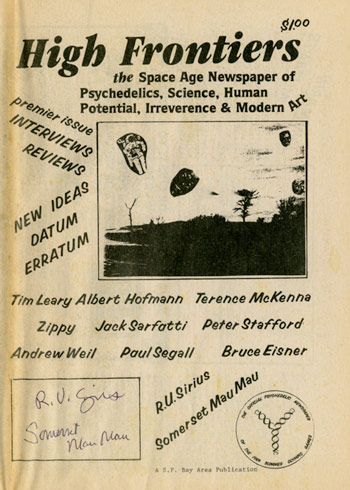 | |
Three incarnations of a magazine co-founded, funded and published by Queen Mu with the better-known editor-in-chief R.U. Sirius. It presented a mixture of cutting-edge technology and psychedelic drugs, suggesting that, just as psychedelics had the potential to change both individual consciousness and world culture, so too did technology. Articles covered topics such as psychedelic software, smart drugs, cyberculture, and, of course, the use of both well-known and novel psychedelics, of which the editors and crew reportedly did mondo quantities. |
|
|
| |
1986 - 1991 | | Encyclopaedia Psychedelica international | AUSTRALIA |
|
|---|
| |
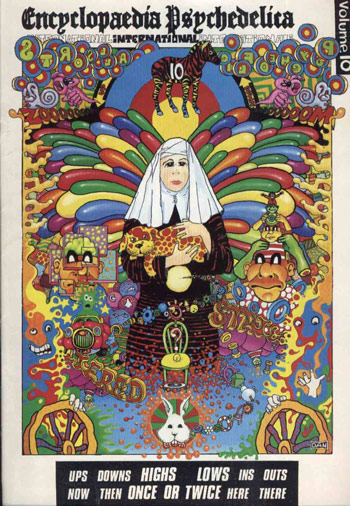 | |
Originally intended to have 100 issues ending in the year 2000, only 15 were produced, with contributors such as Timothy Leary, Ken Kesey, and Charles Bukowski. Founded by Fraser Clark, a Sixties counterculturalist and an early rave promoter in London who also founded the "Zippie" (post-raver, techno-hippie, anti-yuppie) movement, Encyclopaedia Psychedelica international (EPi) had thematic issues on topics such as hippies, paganism, rock festivals, sanity, poetry, psychedelic heroines, Gaia, etc. |
|
|
| |
1988 - Present | | MAPS Bulletin | FL/NC/MA/CA, USA |
|
|---|
| |
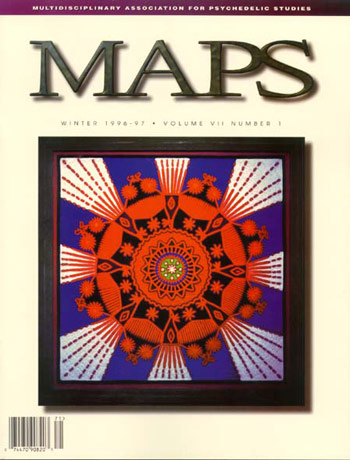 | |
The newsletter of the Multidisciplinary Association for Psychedelic Studies began as a one-page letter and has expanded to a tri-annual, roughly 40-page publication. It was renamed the MAPS Bulletin in 1995. The Bulletin provides updates about MAPS-sponsored research and projects, and articles on medicinal and scientific issues related to psychedelics. Since 2000, special issues have delved into topics such as "Psychedelics, Death and Dying", "Psychedelics and Ecology", and "Kids and Psychedelics". |
|
|
| |
1991 - 1995 | | Integration | GERMANY |
|
|---|
| |
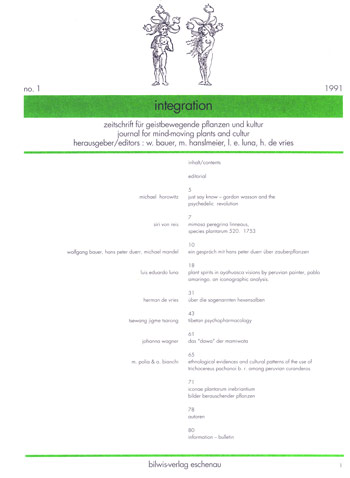 | |
This "Journal for Mind-moving Plants and Culture" had the goal of providing context for the healthy integration of psychoactive substances. It promoted the idea that early cultures did not experience the type of problems the modern world faces with "drugs" because use was embedded and balanced within the cultural, social, and religious lives of the people. Articles ranged from analysis of primitive and traditional use of psychoactive plants to interdisciplinary evidence from artists, botanists, and pharmacologists of their positive value. Five issues were published over four years. |
|
|
| |
1991 - 1995/6 | | Psychedelic Illuminations | CA/WA, USA |
|
|---|
| |
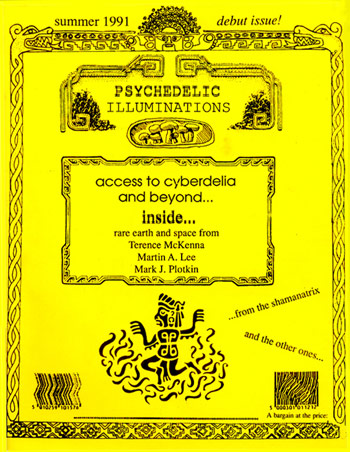 | |
With a goal of "promoting the ideals of expanded consciousness, human evolution, global harmony, and the concept of 'plants as teachers'", Psychedelic Illuminations (PI) aimed at creating a mainstream print resource for current information about psychedelics. Known for its colorful artistic covers and interviews with psychedelic luminaries, PI was sold selectively at newsstands and bookstores around the country, which was somewhat unusual for such a publication. James Kent, managing editor for issues 5-10, went on to publish TRP: The Resonance Project. |
|
|
| |
1992 - 2008 | | The Entheogen Review | CA, USA |
|
|---|
| |
 | |
The Entheogen Review (ER), the "Journal of Unauthorized Research on Visionary Plants and Drugs", went through two incarnations, the first (1992-1997) edited by Jim DeKorne, and an improved version (1998-2008) led by editor David Aardvark. A true underground publication, ER addressed topics avoided by many others: synthesis and extraction techniques, cultivation of psychoactive-containing plants, exploration of novel compounds, rectal administration techniques, and a "Sources" column that identified companies that sold (not-strictly-illegal) psychoactive products. Jon Hanna, a frequent contributor to ER, has been an editor of Erowid Extracts since 2008. |
|
|
| |
1993 - 1999
1999 - 2003 | | The Entheogen Law Reporter
The Journal of Cognitive Liberties | CA, USA |
|
|---|
| |
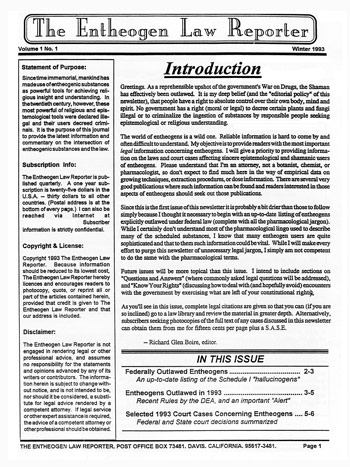 | |
Produced by lawyer Richard Glen Boire, TELR focused narrowly on legal issues related to psychoactives, covering cases, defenses, and enforcement. Approximately 22 issues were published, as well as two compilations. After Boire and his partner Wrye Sententia founded the Center for Cognitive Liberty and Ethics, TELR morphed into the Journal of Cognitive Liberties and expanded to cover more media and cultural critique, with a higher dose of rabble-rousing subversiveness. |
|
|
| |
1995 - 2005 | | Eleusis | ITALY |
|
|---|
| |
 | |
Originally co-edited by Jonathan Ott and Giorgio Samorini for eight issues now described as the "old series" (1995-1997), Eleusis was then taken over by the Museo Civico di Rovereto for nine issues (1998-2005). Eleusis, billing itself as the "Journal of Psychoactive Plants and Compounds", collected research on the relationship between humankind and psychoactives. Articles ranged from evidence of historical uses of entheogens in spiritual practices around the world, to the history of the ritual use of alcohol, to the symbolism of psychoactives and the cultivation of mushrooms. |
|
|
| |
1992 - 1997 | | Island Views | CA, USA |
|
|---|
| |
 | |
Produced by Bruce Eisner (author of Ecstasy: The MDMA Story) as the newsletter of the Island Foundation, a non-profit organization active for only a few years, this publication took its name from Aldous Huxley's 1952 Island utopia. Island Views promoted values such as intentional community, individual freedom, cooperation rather than competition, and methods of consciousness change including the use of psychedelics. Three glossy color issues were titled Psychedelic Island Views. |
|
|
| |
1997 - 2000
2001 - 2003 | | The Resonance Project
Trip | WA, USA |
|
|---|
| |
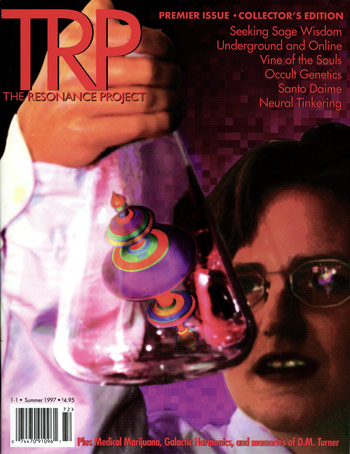 | |
This irreverent subculture magazine produced by James Kent continued where Psychedelic Illuminations left off. TRP/Trip: The Journal of Psychedelic Culture, was a well-produced publication that featured artwork, interviews, and articles related to visionary and psychedelic drug culture. Trip also produced a sketch comedy DVD Tales from the Trip Side, a cynical, goofy collection of timely shorts about recreational drug use. The editorial group went on to create the blog DoseNation.com. Managing editor Scott O. Moore is a member of the Erowid Center board of directors. |
|
|
| |
2001 - Present | | Erowid Extracts | CA, USA |
|
|---|
| |
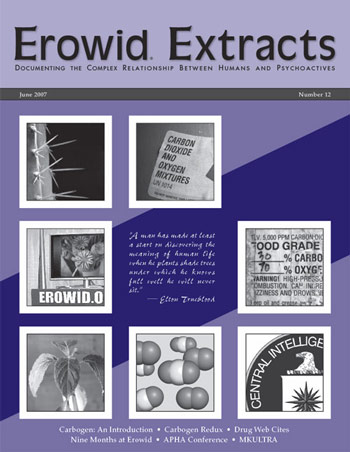 | |
Erowid's newsletter has been published consistently twice a year since mid-2001. It has a distribution of approximately 1,500 with most issues at 28 pages in length. Erowid Extracts, part newsletter and part magazine in style, focuses on psychedelics and newer drugs. Content includes descriptions and updates of current projects, research reviews, statistics about Erowid.org, and original articles on topics that tickle the fancy of the Erowid crew. With the exception of experience reports and recurring columns such as Teafærie and Escottology, the tone tends towards the academic. |
|
|
| |
2001 - 2002 | | Entheos | CA, USA |
|
|---|
| |
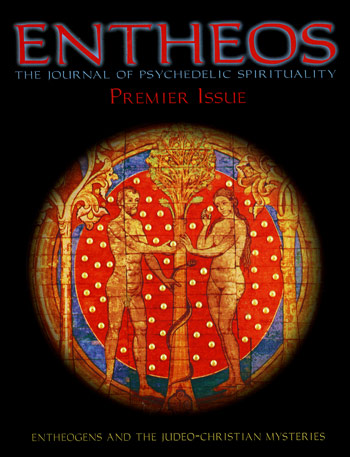 | |
Entheos: The Journal of Psychedelic Spirituality, was a magazine-quality journal (color photos, ~90 pages) dedicated to discussing the use of entheogens for spiritual purposes. It had a small print-on-demand distribution, producing only 400 copies of Issue 1 in its first three printings. Entheos carried both original and reprinted articles by some of the better-known scholars in this field, such as Clark Heinrich, Mark Hoffman, Thomas Lyttle, Jonathan Ott, Carl Ruck, Blaise Staples, K. Trout, and Gordon Wasson. |
|
|
The psychedelic print publications above are some of the most important of the last 50 years, but there are many other notables not included here because they were short-lived or not narrowly psychedelic oriented:
(2007-Present, USA).






















